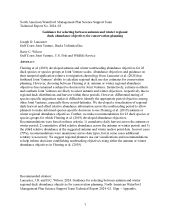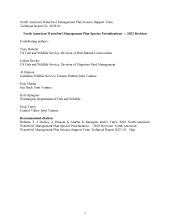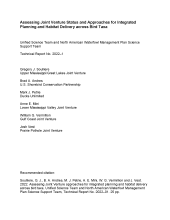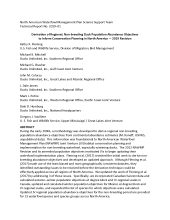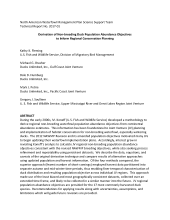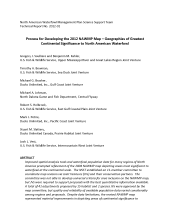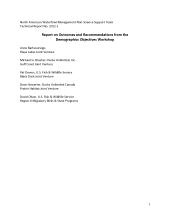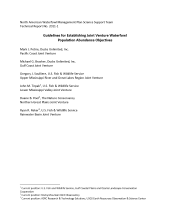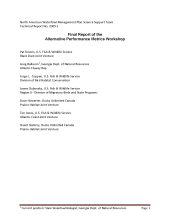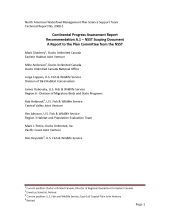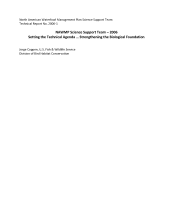EXECUTIVE SUMMARY
Habitat Joint Ventures (JVs) originally formed under the auspices of the North American Waterfowl Management Plan have assumed responsibility for the conservation of multiple bird groups including waterfowl, landbirds, shorebirds, and waterbirds. Using a variety of methods, JVs are identifying the conservation needs for each bird group, which are typically described in JV Implementation Plans. As JVs continue to make progress in establishing conservation objectives for each bird group, there is growing interest in determining how objectives might be integrated across bird groups to increase the efficacy of all-bird conservation. As a result, we assessed and reported integration techniques used by JVs. This effort included developing a set of questions used to interview staff members from all 22 North American habitat JVs and document the current state of bird-taxa integration by the JV community. Joint Venture regional partnerships have unique geographies and distinct political, cultural, historical, and biological features affecting their operations. Our intent was to capture the full range of bird-group integration experiences within JVs.
Joint Venture representatives participating in this assessment indicated appreciation for the opportunity to contribute. Most (59%) JVs responded that their conservation work included consideration of more than one bird group using “common habitats” within planning units, but only three (14%) indicated their planning documents explicitly integrated (combined) habitat conservation objectives for multiple bird taxa. Joint Ventures more advanced in multiple bird-group planning had a strong science foundation linked to species-habitat models and landscape prioritization and often designated focal species or umbrella species as habitat representatives. The waterfowl bird group had the strongest science foundation in the highest proportion (82%) of JVs. Nearly half (45%) of JVs used BCRs as their primary planning units, but many also specified that they “step-down” large BCRs into smaller sub-regions for planning or habitat implementation. Planning for designated focus areas, typically dominated by a primary bird habitat category within a BCR(s), was also common (27% of JVs).
The potential to increase efficiencies related to multiple bird-group planning and habitat delivery was recognized at various scales, ranging from individual projects to planning landscapes to entire JV regions. Most (82%) JVs indicated existing government-funded conservation programs were broadly suitable for delivering JV-established objectives for at least some bird groups. In general, JVs identified the USDA Natural Resource Conservation Service Farm Bill programs as most suitable for implementation, followed closely by projects supported by the North American Wetlands Conservation Act (NAWCA). Two categories — data/knowledge needs (35%) and capacity/resource needs (30%) — were identified by JVs as the most important barriers to increasing integrated conservation across bird taxa. Predictably, the top (65%) solution identified by JVs to eliminate barriers was to increase capacity for science and implementation. The majority of JVs indicated meeting a mission for all-bird conservation required integration of bird-group conservation in some manner.
Regarding measuring effectiveness, no JV identified a dedicated program in place to evaluate their all-bird conservation outcomes beyond site-scale monitoring efforts. Many JVs assume conservation actions targeted at focal species also benefit other birds in specific habitat guilds or occurring in common areas. The most frequently identified opportunities to move integration forward were associated with JV habitat-focus areas for wetland birds (32%) or wetland-grassland-pollinator complexes in cropped landscapes (18%).
Highly variable approaches to integrating multiple bird-taxa objectives and inconsistent spatial planning units among JVs may hamper ability to integrate work across regions sharing common bird cohorts during the full annual cycle. Furthermore, inequity in the knowledge base of various bird groups remains a barrier for achieving integrated conservation of all birds (i.e., science weakness in ≥ 1 taxa area leads to weakness in integration). Although various direct and indirect bird-conservation integration is already taking place, expanded capacity for JVs and their collaboration networks was considered critical to leverage more resources, especially related to expanding and complementary environmental initiatives (e.g., addressing climate change). Moreover, if land cover changes due to development, intensive agriculture, and climate factors continue at current rates, traditional JV decision-support models will become less meaningful. Predicting future bird response to habitat management may be even more uncertain due to accelerated environmental change. Consequently, the focus on customary products (e.g., bird species/guild abundance and distribution) familiar to previous generations of wildlife managers may need to become more pliable as we plan and work in increasingly altered and changing systems. Continued networking among bird scientists, land managers, and other relevant experts will be important to better leverage knowledge and resources to most benefit birds and people.
